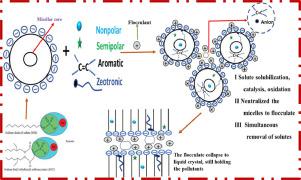Water Research ( IF 12.8 ) Pub Date : 2021-07-07 , DOI: 10.1016/j.watres.2021.117414 Hailu Demissie 1 , Sen Lu 2 , Ruyuan Jiao 3 , Libing Liu 4 , Yu Xiang 5 , Tharindu Ritigala 5 , Fidelis Odedishemi Ajibade 5 , H K M Mihiranga 5 , Guangyu An 3 , Dongsheng Wang 6

|
Among various aqua remediation technologies, separation aims at cleaning pollutants by isolating them despite their destruction; solutes can also be recovered after the process. Adsorptive micellar flocculation (AMF) has been known as an important surfactant-based technique to separate poorly water-soluble hazardous pollutants from aqua media as an efficient and energy-intensive replacement for other surfactant-based techniques, as such AMF should be known. AMF is based on the partitioning of solutes gradient from bulk solution into the nanosized smart anionic surfactant micelle followed by flocculation. However, unlike coagulation/flocculation or adsorption, AMF is not viable for the production of drinking water in water utilities due to the loss of surfactant monomers. Unfortunately, it can be used as a reservoir or for the recycling/recovery of organic pollutants (intermediates) (ions, organics/bioactive, dyes, etc.), even at high concentrations. The performance of AMF depends on various parameters, and this review briefly summarizes the existing researches on different pollutants removal by AMF and material recovery/recycling. This includes operating condition factors (surfactants, flocculants, surfactant-flocculant or surfactant-pollutant concentration ratio, and water conditions chemistry). Because varieties of micro interfacial phenomena other than physical interactions occur in a versatile micellar environment in the AMF process, emphases are given to adsorptive oxidation, micellar catalysis, selectivity. Furthermore, for the first time, this review gives an overview of understanding the state-of-the-art multifunctional nano amphiphile-based AMF that behaves mimetic to aquatic organisms in the process of pollutant removal. The efficiency of AMF, including recycling concentrated solution without noticeable deterioration, as an auxiliary resource/income for the next cycle, signifies economic viability, versatility, and manifold applications in aqua remediation. Significance, ways to achieve enhanced process efficiency, as well as challenges and future opportunities in wastewater treatment, are also highlighted.
中文翻译:

吸附胶束絮凝微界面现象研究进展:水处理原理及应用
在各种水体修复技术中,分离的目的是通过隔离来清洁污染物,尽管它们被破坏了;处理后也可以回收溶质。吸附胶束絮凝 (AMF) 是一种重要的基于表面活性剂的技术,可将难溶于水的有害污染物从水介质中分离出来,作为其他基于表面活性剂的技术的高效且耗能的替代品,因为这种 AMF 应该是众所周知的。AMF 基于将溶质梯度从本体溶液分配到纳米级智能阴离子表面活性剂胶束中,然后进行絮凝。然而,与混凝/絮凝或吸附不同,由于表面活性剂单体的损失,AMF 不适用于自来水公司的饮用水生产。很遗憾,它可以用作蓄水池或用于有机污染物(中间体)(离子、有机物/生物活性物质、染料等)的再循环/回收,即使在高浓度下也是如此。AMF 的性能取决于各种参数,本文简要总结了 AMF 去除不同污染物和材料回收/循环利用的现有研究。这包括操作条件因素(表面活性剂、絮凝剂、表面活性剂-絮凝剂或表面活性剂-污染物浓度比,以及水条件化学)。由于在 AMF 过程中的多功能胶束环境中会发生物理相互作用以外的各种微界面现象,因此重点关注吸附氧化、胶束催化和选择性。此外,第一次,这篇综述概述了对最先进的多功能纳米两亲基 AMF 的理解,该 AMF 在污染物去除过程中模仿水生生物。AMF 的效率,包括在没有明显恶化的情况下回收浓缩溶液,作为下一个循环的辅助资源/收入,意味着经济可行性、多功能性和水体修复中的多种应用。还强调了提高工艺效率的重要性、方法以及废水处理的挑战和未来机遇。标志着水体修复的经济可行性、多功能性和多种应用。还强调了提高工艺效率的重要性、方法以及废水处理的挑战和未来机遇。标志着水体修复的经济可行性、多功能性和多种应用。还强调了提高工艺效率的重要性、方法以及废水处理的挑战和未来机遇。



























 京公网安备 11010802027423号
京公网安备 11010802027423号